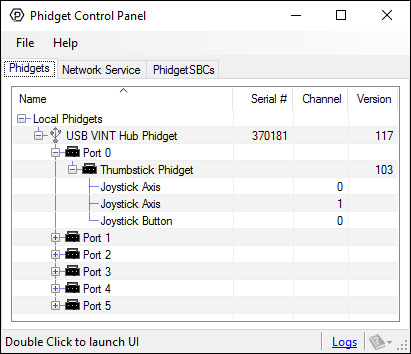HIN1100 User Guide
Required Hardware
- A HIN1100 Thumbstick Phidget
- A USB cable
- A computer
- A 3-wire Phidget cable
- A VINT Hub
Connecting the Pieces
- Connect the VINT Hub to your computer with a USB cable.
- Connect the HIN1100 to the VINT Hub using the Phidget Cable.
Testing Using Windows
Phidget Control Panel
In order to demonstrate the functionality of the HIN1100, the Phidget Control Panel running on a Windows machine will be used.
The Phidget Control Panel is available for use on both macOS and Windows machines.
Windows
To open the Phidget Control Panel on Windows, find the ![]() icon in the taskbar. If it is not there, open up the start menu and search for Phidget Control Panel
icon in the taskbar. If it is not there, open up the start menu and search for Phidget Control Panel
macOS
To open the Phidget Control Panel on macOS, open Finder and navigate to the Phidget Control Panel in the Applications list. Double click on the ![]() icon to bring up the Phidget Control Panel.
icon to bring up the Phidget Control Panel.
For more information, take a look at the getting started guide for your operating system:
Linux users can follow the getting started with Linux guide and continue reading here for more information about the HIN1100.
First Look
After plugging the HIN1100 into your computer and opening the Phidget Control Panel, you will see something like this:

The Phidget Control Panel will list all connected Phidgets and associated objects, as well as the following information:
- Serial number: allows you to differentiate between similar Phidgets.
- Channel: allows you to differentiate between similar objects on a Phidget.
- Version number: corresponds to the firmware version your Phidget is running. If your Phidget is listed in red, your firmware is out of date. Update the firmware by double-clicking the entry.
The Phidget Control Panel can also be used to test your device. Double-clicking on an object will open an example.
Digital Input (Button)
Double-click on a Digital Input Button object in order to run the example: [[Image:{{{1}}}_DigitalInput_Example.jpg|center|link=]]
General information about the selected object will be displayed at the top of the window. You can also experiment with the following functionality:
- {{{2}}}
Voltage Ratio Input (Axis)
Double click on a Joystick Axis object in order to run the example: [[Image:{{{1}}}_VoltageRatioSensor_Example.jpg|center|link=]]
General information about the selected object will be displayed at the top of the window. You can also experiment with the following functionality:
- At the top of the window, information about your device and the properties of this particular channel will be listed.
- On the left, change trigger and/or data interval can be changed. For more information on these settings, see the Data Rate/Change Trigger page.
- On the right, the voltage ratio is reported in volts per volt. In this case, a value of 1.0 corresponds to the maximum tilt in one direction of the axis, and a value of -1.0 corresponds to the maximum tilt in the other direction. Note: The stick will not be able to fully reach the -1.0 or 1.0 position while inside the enclosure.
Joystick Axes
Each axis on the joystick is represented as its own VoltageRatioInput object. Axis 0 and Axis 1 are mapped to channels 0 and 1, respectively. You will have to open both channels to fully track the joystick's position.

Testing Using macOS
- Go to the Quick Downloads section on the macOS page.
- Download and run the Phidget macOS Installer
- Click on System Preferences >> Phidgets (under Other) to activate the Preference Pane
- Make sure your device is properly attached
- Double click on your device's objects in the listing to open them. The Preference Pane and examples will function very similarly to the ones described above in the Windows section.
Testing Using Linux
For a general step-by-step guide on getting Phidgets running on Linux, see the Linux page.
Using a Remote OS
We recommend testing your Phidget on a desktop OS before moving on to remote OS. Once you've tested your Phidget, you can go to the PhidgetSBC, or iOS pages to learn how to proceed.
Technical Details
Converting to Polar Coordinates
For many applications like remote controlled vehicles, you'll want to convert the 2-axis data of the Thumbstick Phidget into an angle and magnitude. You can use the following formulas:
Where r is the magnitude, ϕ is the angle, and x and y are the two axis values. Atan2 is the 2-argument arctangent function, which you can find in most math libraries. For example, in C# you could use Math.Atan2(x,y).
Since x and y range from -1.0 to 1.0, the resulting r will range from to , so you may also want to modify the first formula like so:
This way, your r will range from 0 to 1, which is better when using the Thumbstick Phidget as a controller.
What to do Next
- Programming Languages - Find your preferred programming language here and learn how to write your own code with Phidgets!
- Phidget Programming Basics - Once you have set up Phidgets to work with your programming environment, we recommend you read our page on to learn the fundamentals of programming with Phidgets.





